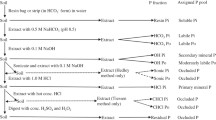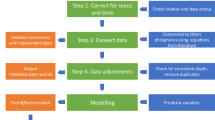Abstract
Background
Low phosphorus (P) soils have been described as a widespread characteristic of the Australian continent and associated with sclerophyll leaf traits. In that context we ask: what proportion of the continent is low-P and how much does this vary between regions?
Methods
9234 locations sampled for soil total P from the Australian National Site Soil Data Collation were analysed. In order to make some adjustment for uneven spatial sampling we area-weighted the data using subregions from the Interim Bioregionalisation of Australia.
Results
Topsoil total P concentrations ≤100 mg kg−1 were widespread, but not a majority of the continent (estimated 25 %). The western Monsoon Tropics (65 %), southwestern Australia (50 %), and southeast South Australia (38 %) were estimated to have larger fractions of the sampled landscape ≤100 mg kg−1 than eastern Australia (13.5 %), but not a lower range of values. Total P values across the continent included a large fraction (33 %) in the range 101–250 mg kg−1.
Conclusions
Continent-wide soil P levels low enough to favour long leaf lifespans for nutrient conservation and a variety of sclerophyll traits were widespread. It is time to move away from the qualitative dichotomies between low- and high-P that have characterised discussion of Australian vegetation, to a more quantitative view.



Similar content being viewed by others
References
Andrews EC (1916) The geological history of the Australian flowering plants. Am J Sci 42:171–232
Asner GP, Knapp DE, Anderson CB, Martin RE, Vaughn N (2016) Large-scale climatic and geophysical controls on the leaf economics spectrum. Proc Natl Acad Sci U S A. doi:10.1073/pnas.1604863113
Australia’s bioregions - IBRA (2012) Department of Sustainability, Environment, Water, Population and Communities. Commonwealth of Australia (Accessed Jan 2016) https://www.environment.gov.au/land/nrs/science/ibra/australias-bioregions-maps
Australia’s ecoregions (2012) Department of Sustainability, Environment, Water, Population and Communities. Commonwealth of Australia (Accessed Jan 2016) https://www.environment.gov.au/system/files/pages/3a086119-5ec2-4bf1-9889-136376c5bd25/files/ecoregionscapad2012.pdf
Beadle NCW (1953) The edaphic factor in plant ecology with a special note on soil phosphates. Ecology 34:426–428
Beadle NCW (1954) Soil phosphate and the delimitation of plant communities in eastern Australia. Ecology 35:370–375
Beadle NCW (1962) Soil phosphate and the delimitation of plant communities in eastern Australia II. Ecology 43:281–288
Beadle NCW (1966) Soil phosphate and its role in molding segments of the Australian flora and vegetation, with special reference to xeromorphy and sclerophylly. Ecology 47:992–1007
Chang SC, Jackson ML (1957) Fractionation of soil phosphorus. Soil Sci 84:133–144
Chen CR, Hou EQ, Condron LM, Bacon G, Esfandbod M, Olley J, Turner BL (2015) Soil phosphorus fractionation and nutrient dynamics along the Cooloola coastal dune chronosequence, southern Queensland, Australia. Geoderma 257–258:4–13
Coomes D, Bentley W, Tanentzap A, Burrows L (2013) Soil drainage and phosphorus depletion contribute to retrogressive succession along a New Zealand chronosequence. Plant Soil 367:77–91
Cornelissen JHC, Aerts R, Cerabolini B, Werger MJA, van der Heijden MGA (2001) Carbon cycling traits of plant species are linked with mycorrhizal strategy. Oecologia 129:611–619
Crisp MD, Cook LG (2013) How was the Australian flora assembled over the last 65 million years? A molecular phylogenetic perspective. Annu Rev Ecol Syst 44:303–324
Cunningham SA, Summerhayes B, Westoby M (1999) Evolutionary divergences in leaf structure and chemistry, comparing rainfall and soil nutrient gradients. Ecol Monogr 69:569–588
Diels L (1906) Die vegetation der Erde 7. Die pflanzenwelt von West-Australien siidlich des wendekreises. Engelmann, Leipzig
Fonseca CR, Overton JM, Collins B, Westoby M (2000) Shifts in trait combinations along rainfall and phosphorus gradients. J Ecol 88:964–977
Hill RS (1998) Fossil evidence for the onset of xeromorphy and scleromorphy in Australian Proteaceae. Aust Syst Bot 11:391–400
Hopper SD (2009) OCBIL theory: towards an integrated understanding of the evolution, ecology and conservation of biodiversity on old, climatically buffered, infertile landscapes. Plant Soil 322:49–86
Johnston R, Barry S, Bleys E, Bui E, Moran C, Simon DP, Carlile P, McKenzie N, Henderson B, Chapman G, Imhoff M, Maschmedt D, Howe D, Grose C, Schoknecht N, Powell B, Grundy M (2003) Asris: the database. Soil Res 41:1021–1036
Jones R, Groves RH, Specht RL (1969) Growth of heath vegetation III. Growth curves for heaths in southern Australia: a reassessment. Aust J Bot 17:309–314
Kruse J, Abraham M, Amelung W, Baum C, Bol R, Kühn O, Lewandowski H, Niederberger J, Oelmann Y, Rüger C, Santner J, Siebers M, Siebers N, Spohn M, Vestergren J, Vogts A, Leinweber P (2015) Innovative methods in soil phosphorus research: a review. J Plant Nutr Soil Sci 178:43–88
Laliberté E, Turner BL, Costes T, Pearse SJ, Wyrwoll K-H, Zemunik G, Lambers H (2012) Experimental assessment of nutrient limitation along a 2-million-year dune chronosequence in the South-Western Australia biodiversity hotspot. J Ecol 100:631–642
Lambers H, Brundrett MC, Raven JA, Hopper SD (2010) Plant mineral nutrition in ancient landscapes: high plant species diversity on infertile soils is linked to functional diversity for nutritional strategies. Plant Soil 334:11–31
Orians GH, Milewski AV (2007) Ecology of Australia: the effects of nutrient-poor soils and intense fires. Biol Rev 82:393–423
Patton RT (1933) The Cheltenham flora. Proc Roy Soc Victoria 45:205–218
Peltzer DA, Wardle DA, Allison VJ, Baisden WT, Bardgett RD, Chadwick OA, Condron LM, Parfitt RL, Porder S, Richardson SJ, Turner BL, Vitousek PM, Walker J, Walker L (2010) Understanding ecosystem retrogression. Ecol Monogr 80:509–529
R Development Core Team R (2015) A language and environment for statistical computing http://www.R-project.org/ (R Foundation for Statistical Computing)
Reed S, Vitousek P, Cleveland C (2011) Are patterns in nutrient limitation belowground consistent with those aboveground: results from a 4 million year chronosequence. Biogeochemistry 106:323–336
Richardson SJ, Peltzer DA, Allen RB, McGlone MS, Parfitt ML (2004) Rapid development of phosphorus limitation in temperate rainforest along the Franz Josef soil chronosequence. Oecologia 139:267–276
Schimper FW (1903) Plant-geography upon a physiological basis. Fisher WR (Transl.) Clarendon Press, Oxford
Searle R (2014) The Australian site data collation to support the GlobalSoilMap. In: Arrouays D, McKenzie N, Hempel J, de Forges AR, McBratney AB (eds) GlobalSoilMap: basis of the global spatial soil information system. CRC Press, London, pp. 127–132
Sparks DL, Page AL, Helmke PA, Loeppert RH (1996) Methods of Soil analysis, Part 3, Chemical Methods. Soil Science Society of America Inc., Madison
Specht RL (1963) Dark Island heath (ninety-mile plain, South Australia) VII the effect of fertilizers on composition and growth, 1950-1960. Aust J Bot 11:67–94
Specht RL (1969a) A comparison of the sclerophyllous vegetation characteristic of Mediterranean type climates in France, California, and southern Australia. I. Structure, morphology, and succession. Aust J Bot 17:277–292
Specht RL (1969b) A comparison of the sclerophyllous vegetation characteristic of Mediterranean type climates in France, California, and southern Australia. II. Dry matter, energy, and nutrient accumulation. Aust J Bot 17:293–308
Specht RL, Rayson P (1957) Dark Island heath (ninety-mile plain, South Australia) I definition of the ecosystem. Aust J Bot 5:52–85
Specht RL, Rundel PW (1990) Sclerophylly and foliar nutrient status of mediterranean-climate plant communities in southern Australia. Aust J Bot 38:459–474
Specht RL, Rayson P, Jackman ME (1958) Dark Island heath (Ninety-Mile Plain, South Australia) VI Pyric succession: changes in composition, coverage, dry weight, and mineral nutrient status. Aust J Bot 6:59–88
Turner BL, Wells A, Andersen KM, Condron LM (2012) Patterns of tree community composition along a coastal dune chronosequence in lowland temperate rain forest in New Zealand. Plant Ecol 213:1525–1541
Vitousek PM, Porder S, Houlton BZ, Chadwick OA (2010) Terrestrial phosphorus limitation: mechanisms, implications, and nitrogen–phosphorus interactions. Ecol Appl 20:5–15
Walker TW, Syers JK (1976) The fate of phosphorus during pedogenesis. Geoderma 15:1–19
Walker J, Thompson CH, Jehne W (1983) Soil weathering stage, vegetation succession, and canopy dieback. Pac Sci 37:471–481
Westoby M (1988) Comparing Australian ecosystems to those elsewhere. Bioscience 38:549–556
Wright IJ, Westoby M (1999) Differences in seedling growth behaviour among species: trait correlations across species, and trait shifts along nutrient compared to rainfall gradients. J Ecol 87:85–97
Wright IJ, Westoby M (2002) Leaves at low versus high rainfall: coordination of structure, lifespan and physiology. New Phytol 155:403–416
Wright IJ, Westoby M (2003) Nutrient concentration, resorption and lifespan: leaf traits of Australian sclerophyll species. Funct Ecol 17:10–19
Wright IJ, Reich PB, Westoby M (2001) Strategy shifts in leaf physiology, structure and nutrient content between species of high- and low-rainfall and high- and low-nutrient habitats. Funct Ecol 15:423–434
Wright IJ, Westoby M, Reich PB (2002) Convergence towards higher leaf mass per area in dry and nutrient-poor habitats has different consequences for leaf life span. J Ecol 90:534–543
Wright IJ, Reich PB, Westoby M (2003) Least-cost input mixtures of water and nitrogen for photosynthesis. Am Nat 161:98–111
Wright IJ, Reich PB, Westoby M, Ackerly DD, Baruch Z, Bongers F, et al. (2004) The worldwide leaf economics spectrum. Nature 428:821–827
Acknowledgments
We thank: State agencies including Department of Land Resource Management, Northern Territory of Australia; Victoria - Department of Economic Development, Jobs, Transport and Resources; New South Wales – Office of Environment and Heritage; Queensland - Department of Science, Information Technology, Innovation and the Arts; and all contributors to the NSSDC for data access. We also thank CSIRO staff including Raphael Viscarra-Rossell, Elisabeth Bui, and Ross Searle for discussions in relation to the SLGA, and Ross Searle for providing the NSSDC data; David Warton (UNSW) for assistance with statistics; Will Cornwell (UNSW) for assistance with R-code for data cleaning, filtering and synthesis; and Ian Wright (MQU) and three anonymous reviewers for providing valuable comments and suggestions. The project was supported by Macquarie University and the Australian Research Council through an Australian Laureate Fellowship to MW. RK was supported by a Postdoctoral Research Fellowship at Macquarie University.
Author information
Authors and Affiliations
Corresponding author
Additional information
Responsible Editor: Hans Lambers.
Electronic supplementary material
ESM 1
(DOCX 210 kb)
Rights and permissions
About this article
Cite this article
Kooyman, R.M., Laffan, S.W. & Westoby, M. The incidence of low phosphorus soils in Australia. Plant Soil 412, 143–150 (2017). https://doi.org/10.1007/s11104-016-3057-0
Received:
Accepted:
Published:
Issue Date:
DOI: https://doi.org/10.1007/s11104-016-3057-0




